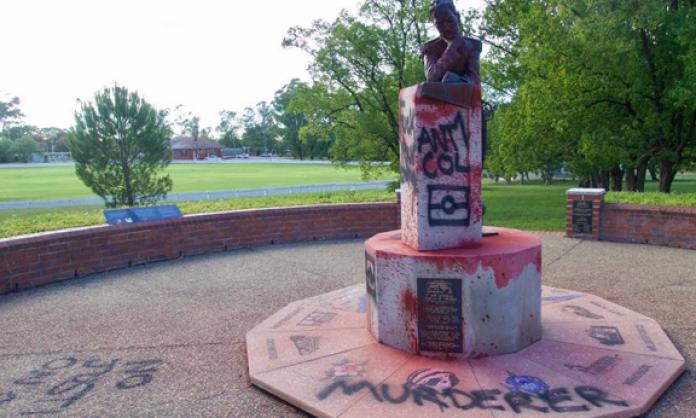The recent toppling of confederate statues in the US should inspire us to tear down some racist statues of our own.
A statue of Lachlan Macquarie in Sydney’s Hyde Park has for years attracted rightful attention and contempt from Indigenous activists and historians. As governor of NSW, 1810-21, Macquarie stole Aboriginal children from their families to assimilate them culturally. In response to Aboriginal resistance, Macquarie ordered punitive massacres and instructed colonial troops to hang the bodies of Aboriginal people from trees, to “strike the greater terror into the survivors”. A plaque near the statue’s base describes this murderer as “a perfect gentleman, a Christian and supreme legislator of the human heart”.
Macquarie’s statue testifies to and celebrates the fact that Australia was founded on dispossession and genocide. This history is reinforced by another prominent statue in Hyde Park, that of Captain Cook. It bears the inscription, “Discovered this territory 1770” – promoting the lie of terra nullius, which was used for so long to justify the British colonial invasion and the racist society constructed after it.
Australian capitalism was built on stolen land and the blood and broken lives of Aboriginal people, and also of Torres Strait and South Sea Islanders. Queensland’s sugar industry was built through the slave labour of at least 62,000 men and women – kidnapped from up to 80 different Pacific islands and brought to Australia in irons to make the fortunes of some of the industry’s most iconic corporations, such as CSR.
A statue of Robert Towns stands just off the main street in Townsville, the city named after this early “entrepreneur”. Towns made his wealth as a slave trader, supplying thousands of trafficked Islanders for indentured labour in the cane fields and maritime industry in the 1860s and ’70s.
Towns later used the spoils of this foul trade to establish a cotton plantation, worked by slaves. For years, the local Islander community in Townsville has been protesting the bronze monument to a grotesque chapter in Australia’s colonial history. It’s a history that extended into the first days of federation. With the establishment of the White Australia policy, thousands of Islander slaves were forcibly deported, separated from their families and dumped, many on islands that weren’t even the ones they or their parents had been abducted from.
The pastoral industry, another cornerstone of Australian capitalism, was made possible by land surveys carried out by men such as Alfred Canning. A monument to him sits by a well on the Canning stock route in Western Australia, which was used to drive cattle until the 1950s.
The state government commissioned Canning to lead an expedition to establish wells across 1,500 kilometres from the Kimberley to the Kalgoorlie gold fields. When the Canning expedition party returned, its cook blew the whistle on the barbaric methods Canning had used to find water. The abuse Canning and his men meted out to the Aboriginal people they encountered was so horrific that it led to a royal commission in 1908.
During the commission, Canning admitted to tying Martu men to trees with rope and chains around their necks, feeding them salt and leaving them in the sweltering heat until they were dying of thirst. At this point they were released and followed until they led the expedition to water. Canning was exonerated of this crime, and also of charges that he raped Aboriginal women, by the testimony of another esteemed “founder” of this country, and Western Australia’s first premier, John Forrest. Forrest, a fellow explorer, claimed that such use of force by Canning was, in Forrest’s experience, common and necessary.
Of course, Forrest has his own imposing statue towering over Kings Park in the centre of Perth. But his legacy lives on in his direct descendant, mining magnate Andrew “Twiggy” Forrest. Not only does Andrew Forrest profit off stolen land, but he is also the architect of the noxious basics card, introduced by the Howard government in 2007, which imposes what is essentially a rations-card system to police Aboriginal people’s incomes.
It’s not just statues that offend. Most place names and street names around the country are a reflection of a racist system.
Logan, one of the first urban areas to have the basics card introduced, is a case in point. Located on the south side of Brisbane and with a high Aboriginal and immigrant population, it is named after Patrick Logan, the commander of the Moreton Bay Penal Colony. Hated by convicts and the Aboriginal population alike for his violence, Logan met a just end when, on an expedition to survey the Brisbane River in 1830, he was killed by Indigenous people. Upon his death, the jailed convicts celebrated with joyful singing for days.
Just as US Confederate statues erected in the 1920s and ’30s not only speak to a racist history but also tell us of the time in which they were put up, a time of racial segregation known as Jim Crow, Australia’s monuments are reflections of a deeply racist present. Macquarie’s statue was commissioned by the NSW government and unveiled with a public ceremony in 2013. The statue of Towns was erected in 2005.
From the closure of Aboriginal communities for mining profits to the NT Intervention, to income quarantining, Black deaths in custody and systematic violence at the hands of police: Australian capitalism continues to be noxiously racist.
We should not only tear down all the racist monuments, but end the racist policies as well.








